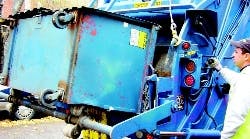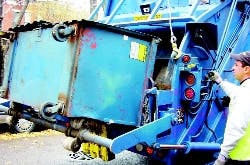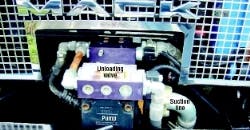Refuse trucks often are heard before they are seen, but running hydraulics at engine idle speeds makes trash days a lot quieter.
By Wes Jackson
Denison Hydraulics
Marysville, Ohio
For about the last year and a half, National Waste Services, Chicago, has seen successful results from testing a new hydraulic pump system on several of its commercial rear loader refuse trucks. Quieter operation and higher efficiency are the two main benefits that have been achieved with this test program. But tests indicate that productivity has improved as well.
As part of the second largest waste collection and recycling company in the United States, National Waste continuously looks for new methods and products to improve its fleet operations and customer service. A new pump technology being tested has been dubbed OASIS (Operate At Standard Idle Speed) by the mobile hydraulics engineering team at Parker Hannifin's Hydraulic Pump Division, formerly Denison Hydraulics, Marysville, Ohio.
OASIS combines a double vane pump with electronically controlled flow management to provide a system that allows refuse trucks to perform their functions with the engine at idle speed — typically about 650 to 700 rpm. This eliminates the need to rev the engine to 1300 to 1800 rpm during collection, thus reducing diesel engine noise. In turn, this allows operating vehicles at any time of day or night without disturbing nearby residents and businesses. The vane pump's wide displacement range and high efficiency at low speed maintain required flow to the hydraulic system at these lower engine speeds.
Conventional refuse trucks use a fixeddisplacement hydraulic pump to provide the flow necessary to operate the hydraulic cylinders that actuate grabbing, lifting, packing, and ejecting the trash collected on the route. With a fixed-displacement pump, however, flow is proportional to engine speed. To operate the hydraulics at a lower engine speed, a larger pump must be used to match the original flow for identical performance. If proper modifications are made to allow higher flows, the OASIS system can improve efficiency on the route. In some cases, test results have shown an eight to 10 second reduction in sweep and pack cycle time, while the engine speed has been cut in half — from 1400 rpm to 700 rpm.
Combatting heat
Heat generation is a concern when increasing the pump displacement to provide flow at these lower engine speeds. Moreover, heat generation can be exacerbated when the engine speed increases during acceleration and over the road conditions. A large OASIS system pump was specified because National Waste wanted to improve its functional cycle times. The large pump introduced the potential of making these undesirable conditions worse. However, the use of the double vane pump provides a method to reduce overall flow when the engine speed increases above idle: by recirculating fluid from the inlet.
With the pump switched on and the engine running at idle, both pump sections combine to provide the necessary flow. Exceeding a preset engine speed (typically above idle) causes one pump section to unload — routing discharge fluid directly back to the pump inlet. This action significantly reduces the output flow to the hydraulic system. Less flow means less heat and lower inlet velocity through the pump's suction hose.
If the engine accelerates above a second preset speed, the second pump section dumps discharge fluid back to the hydraulic reservoir. When this occurs, only a small residual flow is being pumped to the main control system.
This flow control method is contrary to what most truck operators are familiar with; revving the engine actually slows the hydraulic functions down. Because speeding up the engine is counterproductive, operators tend to leave the engine at idle in order to maximize productivity.
Increasing system flow to the truck's hydraulic control circuit still generates more heat during normal truck functions. In order to reduce potential system heat created by the larger OASIS pump, some modifications are performed — such as replacing the original control valves with higher flow versions. Increasing the valve size reduces flow restrictions, thereby reducing heat generation.
Matching pump to engine
As with any type of hydraulic system, a refuse truck's ability to provide the flow and pressure to compact the collected material is ultimately ruled by the diesel engine's available power. Most diesel engines deliver maximum power at speeds well above idle, so the OASIS system operates in a region where many engines might fall short. Depending on the flows and pressures required, an OASIS equipped truck should be specified with a minimum engine power rating of 290-320 hp. With the many variations in engine performance from one manufacturer to another, plus the increasing use of alternative fuel engines, it is important to determine the amount of power an engine delivers at idle speeds prior to installing any type of operate-atidle hydraulic system.
A user's perspective
With all the benefits of operating the truck's hydraulic system at idle, it might be easy to overlook other positive aspects resulting from this test. Some of these additional benefits have been discussed by the actual truck operators, such as Ken Doot, the National Waste operator assigned to test a modified Leach 2RII in Chicago's Lincoln Park region. "The packer cycle is much faster than before, and the truck is packing out the same, even better," Doot reveals. "And I am getting good response from the customers because of the quiet operation. It's great because I don't disturb the surrounding homes and businesses when I am on the street or in an alley picking up."
Doot also mentions that the quieter operation is easier on his own hearing. This allows him to be more aware of his surroundings while operating the truck, adding an unintentional benefit of improved operator safety. Finally, Doot admits, "When it's ten below out here, it's nice to get back into the cab ten seconds faster too."
Bob Bulthuis, fleet maintenance Supervisor for National Waste, is pleased with the system test results and anticipates long-term maintenance benefits by using the OASIS system. "Operating the engine at idle should not only improve fuel economy and reduce noise, I expect it will also reduce normal engine wear and tear because the rev-up features are no longer needed," said Bulthuis.
Over the past four to five years, OASIS systems have been successfully tested on many different types of refuse trucks, including automated side loaders, commercial and residential front loaders, and rear loaders similar to those used at National Waste.
For more information, visit www.denisonshydraulics.com



